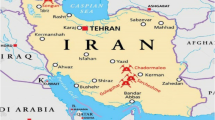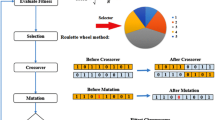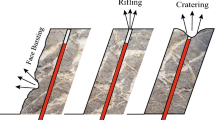Abstract
After the ore (seam) extraction in longwall mining, the immediate roof layers over the extracted panel are strained and suspended downward. This process expands upward and causes the caving and fracturing of damaged roof rock strata. The combination height of the caved and interconnected fractured zones is considered as the height of caving–fracturing zone (HCFZ) in this research. Precise estimation of this height is crucial to the exact determination of directed loads toward the front and sides abutments. The paper describes an intelligent model based on the artificial neural network (ANN) to predict HCFZ. To validate the ability of ANN model, its results are compared to the multivariable regression analysis (MVRA) results. For models construction and evaluation, a wide range of datasets comprising of geometrical and geomechanical characteristics of mined panel and roof strata have been gathered. Performance evaluation indices including determination coefficient (R 2), variance account for, mean absolute error (E a) and mean relative error (E r) have been utilized to assess the models’ capability. Comparison results show that the ANN model performance is considerably better than the MVRA model. Moreover, obtained results are further compared with the results of available in situ, empirical, analytical, numerical and physical models reported in the literature. This comparison confirms that a reasonable agreement exists between the ANN model and the previous comparable methods. Finally, the sensitivity analysis of ANN results shows that the overburden depth has the maximum effect, whereas the Poisson’s ratio has the minimum effect on the HCFZ in this research.






















Similar content being viewed by others
References
Majdi A, Hassani FP, Yousef Nasiri M (2012) Prediction of the height of destressed zone above the mined panel roof in longwall coal mining. Int J Coal Geol 98(1):62–72
Rezaei M, Farouq Hossaini M, Majdi A (2015) A time-independent energy model to determine the height of destressed zone above the mined panel in longwall coal mining. Tunn Undergr Space Technol 47:81–92
Rezaei M, Farouq Hossaini M, Majdi A (2015) Determination of longwall mining-induced stress using the strain energy method. Rock Mech Rock Eng 48(6):2421–2433
Rezaei M, Farouq Hossaini M, Majdi A (2015) Development of a time-dependent energy model to calculate the mining-induced stress over gates and pillars. J Rock Mech Geotech Eng 7(3):306–317
Neaupane KM, Achet SH (2004) Use of backpropagation neural network for landslide monitoring: a case study in the higher Himalaya. Eng Geol 74(3–4):213–226
Khandelwal M, Singh TN (2006) Prediction of blast induced ground vibrations and frequency in opencast mine—a neural network approach. J Sound Vib 289(4–5):711–725
Khoshjavan S, Mazlumi M, Rezai B, Rezai M (2010) Estimation of hardgrove grindability index (HGI) based on the coal chemical properties using artificial neural networks. Orient J Chem 26(4):1271–1280
Bahrami A, Monjezi M, Goshtasbi K, Ghazvinian A (2011) Prediction of rock fragmentation due to blasting using artificial neural network. Eng Comput 27(2):177–181
Rezaei M, Monjezi M, Ghorbani Moghaddam S, Farzaneh F (2012) Burden prediction in blasting operation using rock geomechanical properties. Arab J Geosci 5(5):1031–1037
Majdi A, Rezaei M (2013) Prediction of unconfined compressive strength of rock surrounding a roadway using artificial neural network. Neural Comput Appl 23(2):381–389
Majdi A, Rezaei M (2013) Application of artificial neural networks for predicting the height of destressed zone above the mined panel in longwall coal mining. In: 47th U.S. rock mechanics/geomechanics symposium, 23–26 June, San Francisco, California, USA, pp 1665–1673
Sayadi AR, Tavassoli SMM, Monjezi M, Rezaei M (2014) Application of neural networks to predict net present value in mining projects. Arab J Geosci 7(3):1067–1072
Saghatforoush A, Monjezi M, Shirani Faradonbeh R, Armaghani Jahed D (2016) Combination of neural network and ant colony optimization algorithms for prediction and optimization of flyrock and back-break induced by blasting. Eng Comput 32(2):255–266
Gordan B, Armaghani Jahed D, Hajihassani M, Monjezi M (2016) Prediction of seismic slope stability through combination of particle swarm optimization and neural network. Eng Comput 32(1):85–97
Verma AK, Singh TN, Monjezi M (2010) Intelligent prediction of heating value of coal. Iran J Earth Sci 2:32–38
Singh TN, Verma AK (2012) Comparative analysis of intelligent algorithms to correlate strength and petrographic properties of some schistose rocks. Eng Comput 28(1):1–12
Verma AK (2014) A comparative study of various empirical methods to estimate the factor of safety of coal pillars. Am J Min Metall 2(1):17–22
Verma AK, Maheshwar S (2014) Comparative study of intelligent prediction models for pressure wave velocity. J Geosci Geomat 2(3):130–138
Bhatnagar A, Khandelwal M (2012) An intelligent approach to evaluate drilling performance. Neural Comput Appl 21(4):763–770
Salsani A, Daneshian J, Shariati S, Yazdani-Chamzini A, Taheri M (2014) Predicting roadheader performance by using artificial neural network. Neural Comput Appl 24(7):1823–1831
Stojadinović S, Lilić N, Obradović I, Pantović R, Denić M (2016) Prediction of flyrock launch velocity using artificial neural networks. Neural Comput Appl 27(2):515–524
Yari M, Bagherpour R, Jamali S, Shamsi R (2016) Development of a novel flyrock distance prediction model using BPNN for providing blasting operation safety. Neural Comput Appl 27(3):699–706
Mahdevari S, Shahriar K, Sharifzadeh M, Tannant DD (2016) Stability prediction of gate roadways in longwall mining using artificial neural networks. Neural Comput Appl. doi:10.1007/s00521-016-2263-2
Singh MM, Kendorski FS (1981) Strata disturbance prediction for mining beneath surface water and waste impoundments. In: Proceedings of the first conference on ground control in mining, Uni. West Virginia, pp 76–89
Karmis M, Triplett T, Haycocks C, Goodman G, (1983) Mining subsidence and its prediction in an Appalachian coalfield. Rock mechanics: theory, experiment, practice. In: Proceedings of the 24th US symposium rock mechanics, 20–23 June 1983, Texas A&M University. Balkema, Rotterdam, pp 665–675
Hasenfus GJ, Johnson KL, Su DWH (1998) A hydrogeomechanical study of overburden aquifer response to longwall mining. In: Peng Syd S (ed) Proceedings of the 7th international conference on ground control in mining. West Virginia University, COMER, Department of Mining Engineering, Morgantown, pp 149–162
Booth CJ, Spande ED (1992) Potentiometric and aquifer property changes above subsiding longwall mine panels, Illinois basin coalfield. Groundwater 30(3):362–368
Peng SS (1992) Surface subsidence engineering. The society for mining, metallurgy and exploration, ground control (Mining), p 161
Chekan G, Listak J (1993) Design practices for multiple-seam longwall mines. Information circular 9360. U.S. Dept. of the Interior, Bureau of Mines, Pittsburgh, PA, p 35
Palchik V (2002) Influence of physical characteristics of weak rock mass on height of caved zone over abandoned subsurface coal mines. Environ Geol 42(1):92–101
Palchik V (2003) Formation of fractured zones in overburden due to longwall mining. Environ Geol 44(1):28–38
Palchik V (2010) Experimental investigation of apertures of mining-induced horizontal fractures. Int J Rock Mech Min Sci 47(3):502–508
Tajduś K (2015) Analysis of horizontal displacement distribution caused by single advancing longwall panel excavation. J Rock Mech Geotech Eng 7(3):395–403
Xue J, Wang H, Zhou W, Ren B, Duan C, Deng D (2015) Experimental research on overlying strata movement and fracture evolution in pillarless stress-relief mining. Int J Coal Sci Technol 2(1):38–45
Bai JB, Shen WL, Guo GL, Wang XY, Yu Y (2015) Roof deformation, failure characteristics, and preventive techniques of gob-side entry driving heading adjacent to the advancing working face. Rock Mech Rock Eng 48(6):2447–2458
Ming-he J, Xue-hua L, Qiang-ling Y, Dong-wei L, Zhao-hui C, Jian Z (2015) Numerical investigation into effect of rear barrier pillar on stress distribution around a longwall face. J Cent South Univ 22(11):4372–4384
Palchik V (2015) Bulking factors and extents of caved zones in weathered overburden of shallow abandoned underground workings. Int J Rock Mech Min Sci 79:227–240
Qu Q, Xu J, Wu R, Qin W, Hu G (2015) Three-zone characterisation of coupled strata and gas behaviour in multi-seam mining. Int J Rock Mech Min Sci 78:91–98
Yu B, Zhao J, Kuang T, Meng X (2015) In situ investigations into overburden failures of a super-thick coal seam for longwall top coal caving. Int J Rock Mech Min Sci 78:155–162
Jiachen W, Shengli Y, Dezhong K (2016) Failure mechanism and control technology of longwall coalface in large-cutting-height mining method. Int J Min Sci Technol 26(1):111–118
Meng Z, Shi X, Li G (2016) Deformation, failure and permeability of coal-bearing strata during longwall mining. Eng Geol 208(24):69–80
Zhu S, Yu F, Jiang F (2016) Determination of abutment pressure in coal mines with extremely thick alluvium stratum: a typical kind of rockburst mines in China. Rock Mech Rock Eng 49(5):1943–1952
Yu B, Zhang Z, Kuang T, Liu J (2016) Stress changes and deformation monitoring of longwall coal pillars located in weak ground. Rock Mech Rock Eng 49(8):3293–3305
Basheer IA, Hajmeer M (2000) Artificial neural networks: fundamentals, computing, design, and application. J Microbiol Methods 43(1):3–31
Demuth H, Beal M, Hagan M (1996) Neural network tool box 5 user’s guide. The Math Work, Natick
Jennrich RI (1995) An introduction to computational statistics-regression analysis. Prentice Hall, Englewood Cliffs, NJ
Tzamos S, Sofianos AI (2006) Extending the Q system’s prediction of support in tunnels employing fuzzy logic and extra parameters. Int J Rock Mech Min Sci 43(6):938–949
Rezaei M, Majdi A, Monjezi M (2014) An intelligent approach to predict unconfined compressive strength of rock surrounding access tunnels in longwall coal mining. Neural Comput Appl 24(1):233–241
Rezaei M, Asadizadeh M, Majdi A, Farouq Hossaini M (2015) Prediction of representative deformation modulus of longwall panel roof rock strata using Mamdani fuzzy system. Int J Min Sci Technol 25(1):23–30
Fawcett RJ, Hibberd S, Singh RN (1986) Analytic calculations of hydraulic conductivities above longwall coal face. Int J Mine Water 5(1):45–60
Follington IL, Isaac AK (1990) Failure zone development above longwall panels. Min Sci Technol 10(2):103–116
Mills K, O’Grady P (1998) Impact of longwall width on overburden behavior. In: Aziz N (ed) Coal 98: Coal operators’ conference, University of Wollongong and The Australasian Institute of Mining and Metallurgy, pp 147–155
Jong YH, Lee CI (2004) Influence of geological conditions on the powder factor for tunnel blasting. Int J Rock Mech Min Sci 41(1):533–538
Author information
Authors and Affiliations
Corresponding author
Ethics declarations
Conflict of interest
The authors declare that there is no conflict of interest.
Rights and permissions
About this article
Cite this article
Rezaei, M. Development of an intelligent model to estimate the height of caving–fracturing zone over the longwall gobs. Neural Comput & Applic 30, 2145–2158 (2018). https://doi.org/10.1007/s00521-016-2809-3
Received:
Accepted:
Published:
Issue Date:
DOI: https://doi.org/10.1007/s00521-016-2809-3




